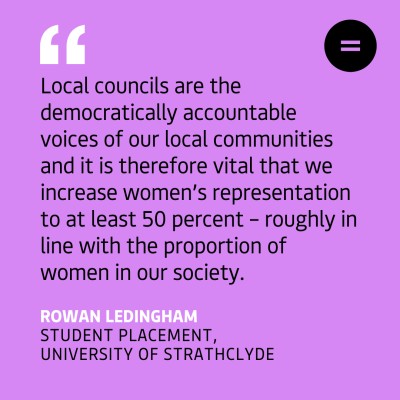Engender blog
GUEST POST: Women and Local Council Elections in Scotland
Today we're publishing the first in a series of blogs from the current student placements Engender is hosting from the University of Strathclyde Applied Gender Studies and Research Methods course.
In this post, Rowan discusses women's representation in local councils, and will be researching about why some women that were previously elected are not re-standing in the local council elections in May 2022. You can read Rowan's second blog here.
When I decided to apply to the Applied Gender Studies masters at Strathclyde, the prospect of a research placement at Engender was a big factor in my decision. Naturally, I am now thrilled to be a part of this organisation’s research into the experiences of female local councillors in Scotland and the reasons behind some women’s decision to stand down in the May 2022 elections.
The overrepresentation of men in positions of power in Scotland was made evident in Engender’s 2020 Sex & Power Report. More specifically, we saw that women make up just 29 percent of elected councillors at local authority level. Unequal gender representation in local councils reflects and compounds inequality in society, since we know the narrower the range of backgrounds, the narrower the range of experiences that are brought to the fore in political decision making. Local councils are the democratically accountable voices of our local communities and it is therefore vital that we increase women’s representation to at least 50 percent – roughly in line with the proportion of women in our society. On a more positive note, we now have a record share of MSPs, 45 percent, who identify as female. We are hopeful that similar progress will be made in the local council elections in May.
It is worth noting that there are currently no requirements to collect or publish information on the equality characteristics of candidates for elections in Scotland. This is because the UK Government did not enact Section 106 of the Equality Act to require that all parties are legally responsible to publish demographic data on their candidates ahead of any election. When this is combined with the paucity of information available on independent candidates, understanding the true diversity of candidates in our local authorities is somewhat challenging.
At the end of 2021, the Scottish Government set out plans to collect data on the diversity of candidates and elected representatives in the May 2022 elections. A questionnaire was designed to ask candidates questions about the protected characteristics set out in the Equality Act and to capture additional information on the socio-economic status, previous parliamentary experience and caring responsibilities of candidates. However, the questionnaire did not include questions exploring the experiences of candidates and any barriers they faced in seeking to become or while serving as a councillor.
The COSLA Barriers to Elected Office Special Interest Group has undertaken work to increase the diversity of local councillors and address the barriers to elected office. There are a number of key themes that emerge from their research:
- Remuneration. Councillors are unfairly compensated for the responsibility and workload of the modern councillor.
- Working hours. Councillors work full-time equivalent hours, making it difficult to maintain secondary employment.
- Working practices. Councillors face challenges when balancing other caring responsibilities with the role.
- Support. There is often a lack of support services from political parties and especially for independent councillors.
- Culture. Councillors are at greater risk of scrutiny, harassment and abuse than the average citizen.
Taking account of gaps in the current research and the barriers to elected office highlighted by COSLA, Engender’s research will focus on why female councillors are choosing to stand down from their position in the May 2022 elections. The hope is that this research will provide a more complete picture of women’s experiences in local government, the reasons why they choose to leave their role and the possible barriers to women’s equal representation in local councils.
In order to meet my research aim, I will interview female councillors from both rural and urban authorities to discuss their experiences and explore the reasons why they are not seeking re-election. I aim to interview 10 councillors from a sample of 4 or 5 different local authorities. Attempts will be made to achieve an acceptable geographical spread within the sample. Data from the interviews will be presented in a final report, and patterns and themes that emerge from the data will be explored and comparisons drawn between urban and rural authorities, as well as between independent and party-affiliated councillors. In addition, the report will present statistics and a breakdown of the gender representation of the candidates from the research sample.
I look forward to exploring this important area of research with Engender over the next few months.
Engender occasionally works with students as part of their placement requirements for university or college courses - this allows students to work with Engender on specific areas of our work for women's equality. Student blogs form part of their course assessment, and they do not receive payment from Engender.
Share this post on …
Comments: 0 (Add)
Sign up to our mailing list
Receive key feminist updates direct to your inbox:

